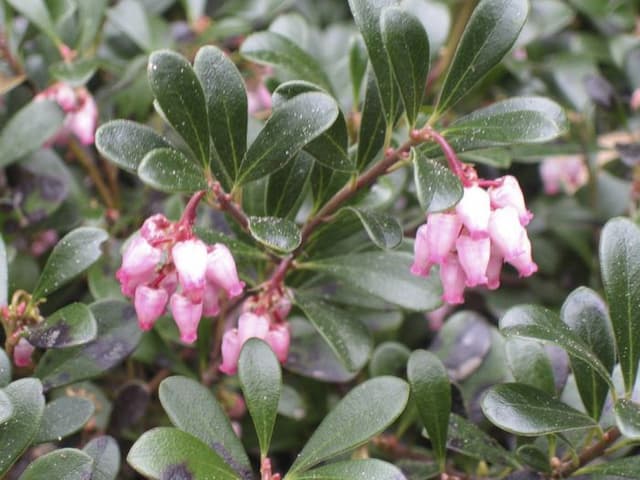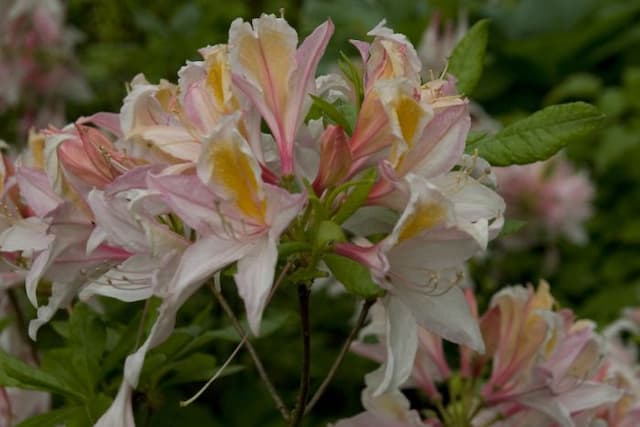Rhododendron Rhododendron 'Old Port'

ABOUT
Rhododendron 'Old Port' is a striking plant cherished for its beautiful flowers and dense foliage. It typically blooms in mid-spring, showcasing clusters of blossoms that can come in shades of deep purple, which may appear almost velvety in texture. Each flower is trumpet-shaped and can have a slightly wavy edge, giving them a ruffled look that adds to their ornamental appeal. The leaves of Rhododendron 'Old Port' are evergreen, maintaining their lustrous, dark green appearance throughout the year. They are thick, leathery, and have a glossy finish that contrasts elegantly with the rich color of the blooms. The shape of the leaves is generally elliptical, and they often come to a point at the tip. The foliage arrangement is dense and can create a lush, full display that provides visual interest even when the plant is not in flower. Rhododendron 'Old Port' is well-suited for use as a specimen plant or as part of a border, where its attractive flowers and foliage can really stand out. Its aesthetic makes it a popular choice for gardens desiring a touch of vivid color and an elegant structure. The plant's overall appearance exudes a classic charm fit for a variety of garden styles.
About this plant
 Names
NamesSynonyms
Old Port Rhododendron, Catawba Rhododendron.
Common names
Rhododendron 'Old Port'.
 Toxicity
ToxicityTo humans
The Rhododendron is poisonous to humans. Ingesting any part of the plant can cause symptoms such as vomiting, diarrhea, hypersalivation, weakness, and coma in severe cases. Consuming Rhododendron can also lead to a drop in blood pressure and can affect the heart rhythm, potentially resulting in fatal consequences if not treated promptly.
To pets
The Rhododendron is toxic to pets. If pets ingest any part of the plant, it can cause symptoms similar to those in humans, including vomiting, diarrhea, drooling, weakness, and potentially leading to coma or death. It is particularly dangerous for animals like dogs and cats, as it can also result in a significant decrease in blood pressure, seizures, and cardiac failure.
 Characteristics
CharacteristicsLife cycle
Perennials
Foliage type
Evergreen
Color of leaves
Green
Flower color
Purple
Height
6 feet (1.83 meters)
Spread
5 feet (1.52 meters)
Plant type
Shrub
Hardiness zones
5
Native area
Asia
Benefits
 General Benefits
General Benefits- Ornamental Appeal: Rhododendron 'Old Port' is valued for its beautiful flowers, which enhance the aesthetic of gardens and landscapes.
- Landscape Versatility: This plant can be used in various landscape designs such as foundation plantings, borders, or as a specimen plant.
- Attracts Pollinators: The flowers attract bees, butterflies, and other pollinators, which are beneficial for the ecosystem.
- Shade Tolerance: Rhododendron 'Old Port' grows well in partial shade, making it suitable for under-canopy plantings in wooded areas.
- Seasonal Interest: It provides year-round interest with evergreen foliage and a stunning floral display in the spring.
 Medical Properties
Medical PropertiesThis plant is not used for medical purposes.
 Air-purifying Qualities
Air-purifying QualitiesThis plant is not specifically known for air purifying qualities.
 Other Uses
Other Uses- Rhododendron 'Old Port' can be used for natural dyes, providing various shades of yellow, brown, and pink depending on the parts used and mordant applied.
- The wood of this plant can be carved into small objects or utensils, as it is quite dense and fine-grained.
- In bonsai, Rhododendron 'Old Port' can be cultivated for its aesthetic shape and beautiful flowers.
- The leaves may be used to prepare a natural insect repellent by crushing and boiling them to release the active compounds.
- Rhododendron species have been used traditionally to make smoking mixtures by certain cultures due to the sedative effects of some species (note: this can be dangerous due to the plant's toxicity).
- The sap can sometimes be used as a basis for adhesives, particularly for traditional crafts where synthetic glues aren't preferred.
- Dense rhododendron shrubs, like 'Old Port', can be planted as a noise barrier due to their thick foliage.
- The flowers can serve as a natural source for a pH indicator, changing color depending on the acidity or alkalinity of a solution.
- This rhododendron can be used as a companion plant in gardens, helping to provide shade for more delicate plants or shelter beneficial insects.
- Photographers and artists sometimes use 'Old Port' as a subject in their work to capture the beauty of its flowers and structure.
Interesting Facts
 Feng Shui
Feng ShuiRhododendron is not used in Feng Shui practice.
 Zodiac Sign Compitability
Zodiac Sign CompitabilityRhododendron is not used in astrology practice.
 Plant Symbolism
Plant Symbolism- Caution and Danger: Rhododendrons, in general, are known to be toxic. So, this plant may symbolize caution or warn of danger due to its poisonous nature.
- Beware: The toxic nature of rhododendrons can also convey a message of "beware" - either of a physical risk or metaphorically, to be cautious in one's actions or decisions.
- Elegance and Wealth: Rhododendrons are often associated with elegance due to their large, beautiful blooms and are sometimes seen as a symbol of wealth or affluence.
- Taking Care of Oneself: Reflective of their toxic properties, this plant might also represent the idea of self-care and setting boundaries for safety.
- Staying Lonely: The fact that rhododendrons can thrive in isolated areas may symbolize a preference for solitude or self-reliance.
 Water
WaterRhododendrons prefer consistent moisture, but it's important not to overwater them. For Rhododendron 'Old Port,' water deeply once a week, providing about 1 inch of water each time which amounts to approximately 0.623 gallons per square foot. During hot or dry weather, increase the frequency to twice a week while in cooler, rainy periods you may need to water less often. Always check the top few inches of soil for dryness before watering again to prevent over-saturating the soil. Overwatering can lead to root rot, so it's crucial to ensure good drainage and let the soil dry slightly between watering sessions.
 Light
LightRhododendron 'Old Port' thrives in areas with dappled shade or filtered light. It is best to avoid direct afternoon sunlight which can scorch the leaves. A spot that receives morning sun and afternoon shade is ideal, or a location under the canopy of tall trees that allows light to filter through. Ensure that the plant is protected from harsh winter winds which can desiccate the foliage.
 Temperature
TemperatureRhododendron 'Old Port' performs well in temperate climates and can tolerate a temperature range from around 20°F to 80°F. The ideal temperature for growth and flowering lies between 60°F and 70°F. Extended temperatures below 20°F or above 80°F can stress the plant, potentially causing damage or inhibiting bloom.
 Pruning
PruningPrune Rhododendron 'Old Port' to maintain shape, remove dead or diseased branches, and promote vigorous growth. The best time for pruning is immediately after the blooming period in the spring. This timing allows the plant to set buds for the next year's flowers. Prune lightly each year as heavy pruning can reduce flowering.
 Cleaning
CleaningAs needed
 Soil
SoilThe best soil mix for the Rhododendron, commonly known as Azalea, should be well-draining, rich in organic matter, and have an acidic pH between 4.5 to 6.0. A mix of 50% peat moss, 30% pine bark, and 20% perlite or coarse sand is ideal, helping to maintain moisture while allowing proper aeration for roots.
 Repotting
RepottingAzaleas should be repotted every 2 to 3 years, or when they become root-bound. It's best to repot in the early spring just before new growth begins, using an acid-focused planting mix suitable for Rhododendrons. Repotting helps to replenish the soil's nutrients and provide space for continued root growth.
 Humidity & Misting
Humidity & MistingAzaleas prefer a moderately high humidity level, around 50-60%. Providing a humid environment can be especially important when grown indoors or in dry climates. However, good air circulation is also necessary to prevent fungal diseases, so balance humidity with adequate airflow.
 Suitable locations
Suitable locationsIndoor
Place Azalea in bright, indirect light; keep soil moist, not soggy.
Outdoor
Choose partial shade location; mulch roots; protect from extreme cold.
Hardiness zone
5-8 USDA
 Life cycle
Life cycleThe Rhododendron 'Old Port', commonly known as Old Port Rhododendron, begins its life cycle from a seed, which germinates when conditions are favorable—typically in moist, well-drained soil with ample shade. The seedling stage follows, during which the plant establishes its root system and begins to grow leaves. Following the seedling stage, the Old Port Rhododendron enters the vegetative stage where it focuses on growth and develops a sturdy stem, more complex root systems, and larger leaves. As it matures, the rhododendron reaches the flowering stage, producing vibrant flowers that are typically purple, which attract pollinators for sexual reproduction. After pollination, the flowers develop into seed capsules, which eventually dry and release seeds, thus completing the reproductive cycle. Lastly, if environmental conditions become unfavorable, the plant may enter a period of dormancy, particularly in colder climates, to conserve energy and resources until favorable conditions return.
 Propogation
PropogationPropogation time
Spring-early summer
Propogation: The Rhododendron 'Old Port', commonly known as Old Port Rhododendron, is typically propagated through semi-hardwood cuttings. This method is usually performed in the late summer, after the plant's new growth has begun to mature and harden slightly. You will take cuttings of about 4 to 6 inches in length, ensuring each cutting has several sets of leaves. The lower leaves are removed, and the cut end is often treated with a rooting hormone to encourage root development. The prepared cuttings are then inserted into a pot filled with a porous rooting mix, such as half peat and half perlite, and kept under high humidity and indirect light until roots have formed, which may take several weeks. Once rooted, the cuttings can be potted up individually and gradually acclimated to less humid conditions before being planted out.









